Why Does Jewelry Turn Skin Green?
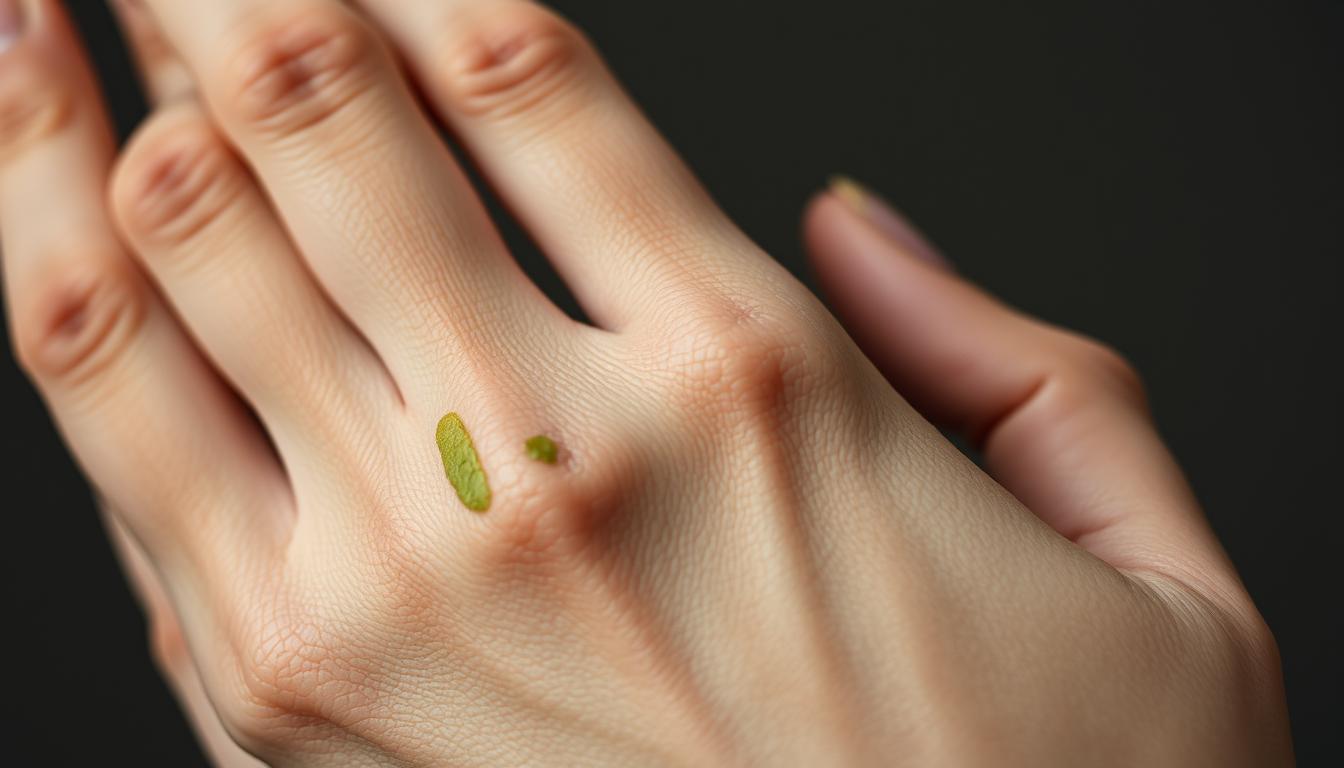
Have you ever noticed a green residue on your skin after wearing certain jewelry pieces? This phenomenon is not only unappealing but also raises concerns about the safety and quality of the jewelry.
According to dermatologist Jennifer Adams, MD, the green residue isn’t harmful and can be washed off with soap and water. The discoloration is a result of a chemical reaction called oxidation between the copper metal and substances like water or chemicals.
Understanding the chemistry behind this reaction is crucial to alleviating concerns and ensuring the quality of jewelry. At our company, we prioritize the use of high-quality materials and advanced technology to minimize the risk of jewelry skin discoloration.
Key Takeaways
- Oxidation causes jewelry to turn skin green.
- The green residue is not harmful and can be washed off.
- Copper metal reacts with substances like water or chemicals.
- High-quality materials and technology can minimize discoloration.
- Understanding the chemistry behind the reaction is crucial.
The Chemistry of Skin Discoloration from Jewelry
Understanding why jewelry causes skin discoloration requires delving into the chemistry behind it. The interaction between jewelry metals and human skin is complex, involving various chemical reactions that can lead to the undesirable green discoloration.
The Oxidation Process on Skin
The oxidation process is a primary factor in jewelry-induced skin discoloration. When metals like copper come into contact with sweat, lotions, or other substances on the skin, they undergo oxidation. This reaction results in the formation of compounds that can cause the skin to turn green. Copper, a common component in many jewelry alloys, is particularly prone to oxidation, leading to this discoloration.
“The reaction occurs because copper is highly reactive, especially when exposed to oxygen and moisture,” explains the underlying chemistry. As copper oxidizes, it forms copper oxide, which can then react with other substances on the skin, such as chlorides in sweat, to form copper chloride, a greenish compound.
How Body Chemistry Influences Reactions
Individual body chemistry plays a significant role in how jewelry interacts with the skin. Factors such as skin pH, sweat composition, and the presence of lotions or perfumes can influence the likelihood and severity of skin discoloration. For instance, individuals with higher sweat production or those who use certain personal care products may experience more pronounced reactions.
Moreover, metal allergies can also exacerbate skin reactions. Some people may be allergic to certain metals used in jewelry, such as nickel, which can cause additional skin irritation and increase the risk of discoloration.
By understanding these chemical processes and how body chemistry influences them, we can better appreciate the complexities involved in jewelry-induced skin discoloration. This knowledge is crucial for developing strategies to prevent or mitigate such reactions.
Why Does Jewelry Turn Skin Green? The Complete Explanation
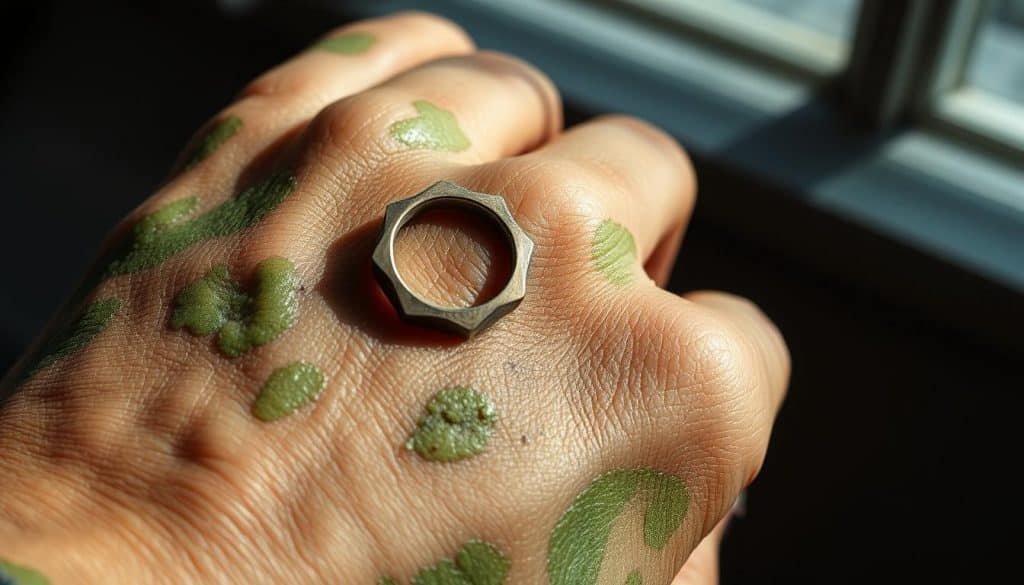
Understanding why jewelry causes skin discoloration requires a deep dive into the science of metal corrosion. When metals corrode, they undergo chemical reactions that can lead to the formation of compounds that cause skin discoloration.
The Science of Metal Corrosion
Metal corrosion is a complex process that involves the reaction of metals with their environment. Copper, a common metal used in jewelry, is particularly prone to corrosion when exposed to air, water, and human sweat. This corrosion process leads to the formation of copper oxide and copper carbonate, which are green in color.
The corrosion of metals like copper is accelerated by factors such as humidity, sweat, and exposure to chemicals. When copper corrodes, it releases ions that can react with the skin, leading to the characteristic green discoloration.
Environmental Factors That Accelerate Reactions
Several environmental factors can accelerate the corrosion process and increase the likelihood of skin discoloration. These include:
- High humidity
- Exposure to chlorine and other chemicals
- Increased sweat due to physical activity
Understanding these factors is crucial in mitigating the risk of skin discoloration from jewelry.
| Environmental Factor | Effect on Metal Corrosion |
|---|---|
| High Humidity | Increases moisture, accelerating corrosion |
| Chlorine Exposure | Reacts with metals, enhancing corrosion |
| Physical Activity | Increases sweat, which can accelerate corrosion |
Metals That Commonly Cause Green Skin
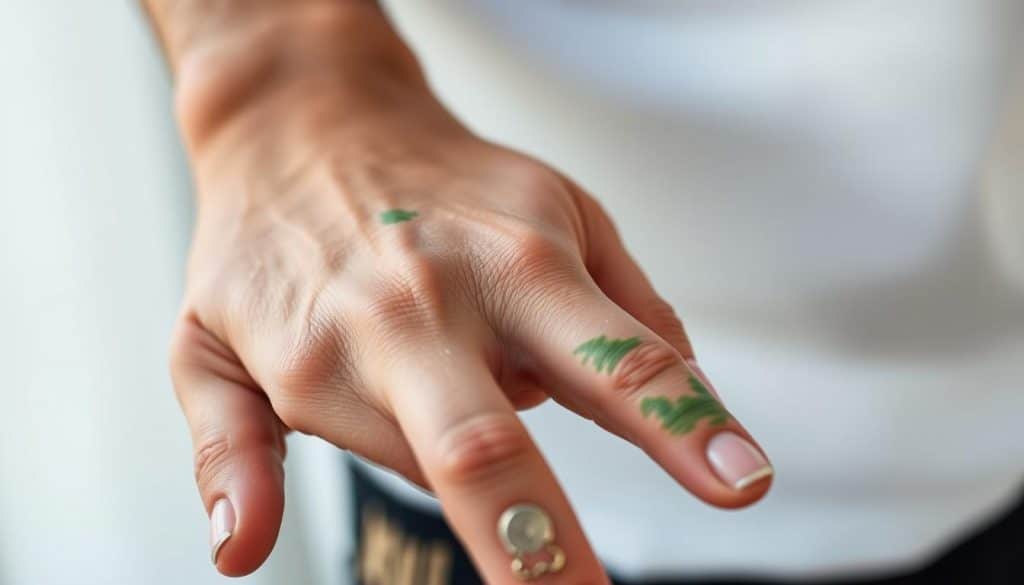
Some metals used in jewelry are notorious for causing green skin discoloration. This issue is not just about aesthetics; it can also indicate a reaction to certain metals. We will explore the primary metals responsible for this phenomenon.
Copper: The Primary Culprit
Copper is one of the most common metals associated with green skin. When copper oxidizes, it forms compounds that can cause skin discoloration. Copper jewelry, especially when not plated or coated, is more likely to cause this issue. The oxidation process is accelerated by exposure to air, moisture, and sweat.
Here are some key points about copper and skin discoloration:
- Copper reacts with oxygen, leading to the formation of copper oxide.
- Moisture and sweat can accelerate the oxidation process.
- Copper jewelry that is not properly coated or plated is more likely to cause skin reactions.
Brass and Bronze Jewelry Effects
Brass and bronze are alloys that contain copper, making them potential culprits for green skin. The higher the copper content, the greater the likelihood of skin discoloration. Brass, an alloy of copper and zinc, and bronze, an alloy of copper and tin, can both cause reactions, especially when exposed to certain environmental conditions.
Some factors that influence the likelihood of brass and bronze causing green skin include:
- The proportion of copper in the alloy.
- Exposure to moisture and chemicals.
- The presence of other reactive metals in the alloy.
Nickel and Other Reactive Metals
Nickel is another metal commonly associated with skin reactions, including discoloration and allergic contact dermatitis. Nickel-plated jewelry can cause severe reactions, especially in individuals with nickel sensitivity. Other reactive metals, such as lead and cadmium, can also contribute to skin issues when used in jewelry.
Key considerations for nickel and other reactive metals include:
- Nickel is a common allergen that can cause skin reactions.
- Jewelry made with nickel or nickel-plated can lead to severe reactions.
- Regulations in many countries restrict the use of nickel in jewelry due to its potential health risks.
Gold Jewelry and Skin Discoloration
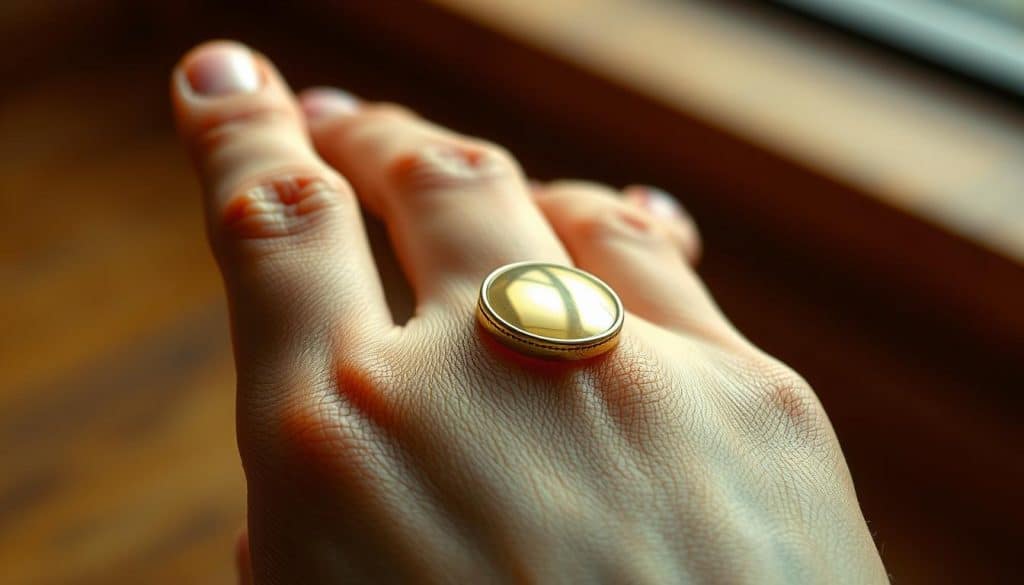
While gold is generally considered hypoallergenic, certain types of gold jewelry can lead to skin discoloration. The purity and alloy composition of gold jewelry play significant roles in determining its potential to cause skin reactions.
Understanding Karat Purity
Gold purity is measured in karats (kt), with 24kt being pure gold. However, pure gold is often too soft for jewelry, so it’s alloyed with other metals to enhance durability. The most common gold purities are:
- 10kt: 41.7% gold
- 14kt: 58.3% gold
- 18kt: 75% gold
- 22kt: 91.6% gold
The lower the karat rating, the higher the proportion of other metals, which can increase the risk of skin discoloration.
Gold Alloys and Their Effects on Skin
Gold alloys are mixed with metals like copper, silver, and nickel to improve strength and change color. These metals can react with skin, especially when exposed to moisture or certain chemicals.
For instance, copper, a common alloying metal, can oxidize and cause green skin discoloration. The risk is higher with lower karat gold jewelry due to its higher copper content.
White Gold vs. Yellow Gold Reactions
White gold and yellow gold have different alloy compositions, affecting their potential to cause skin reactions.
- Yellow Gold: Typically alloyed with copper and silver, yellow gold can cause skin discoloration, especially if it contains a higher percentage of copper.
- White Gold: Often mixed with nickel, manganese, or palladium, white gold can be more problematic for individuals with nickel allergies. The rhodium plating used to give white gold its bright appearance can wear off, exposing the underlying metal.
Understanding the composition of your gold jewelry is crucial in minimizing the risk of skin discoloration. Opting for higher karat gold or hypoallergenic alternatives can help reduce potential reactions.
Silver Jewelry: Does It Turn Skin Green?
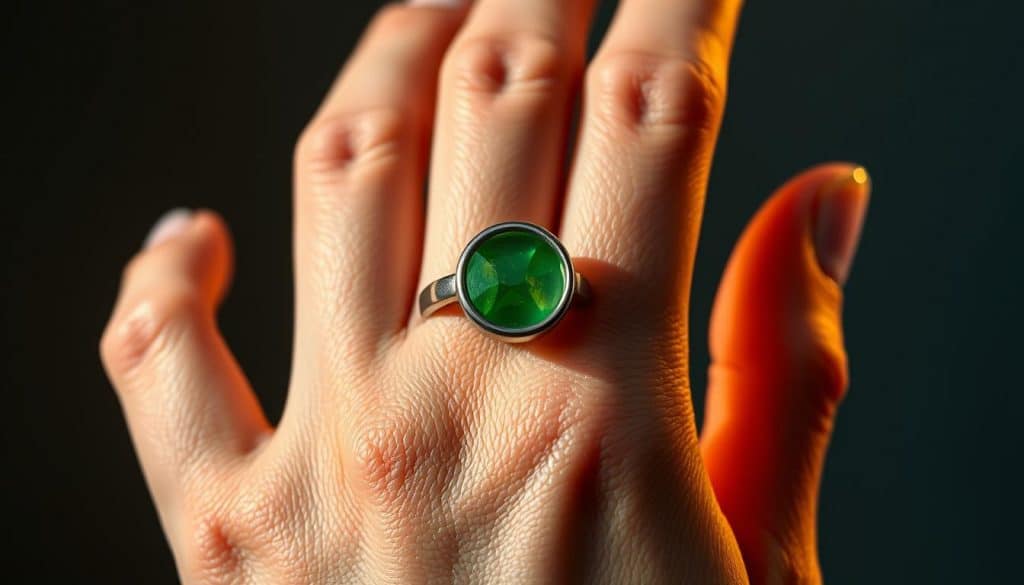
As a timeless and elegant choice, silver jewelry’s potential to cause skin reactions is a concern for many wearers. We explore the intricacies of silver jewelry and its impact on skin, focusing on sterling silver, fine silver, and plated silver.
Sterling Silver Composition and Reactions
Sterling silver, comprising 92.5% silver and 7.5% other metals (usually copper), is a popular choice for jewelry. The addition of copper enhances durability but can also lead to skin discoloration in some individuals. When sterling silver reacts with sweat, air, and other environmental factors, it can cause a greenish tint on the skin.
The reaction is not solely due to the silver itself but the presence of copper and other metals. These metals can oxidize, leading to the formation of compounds that cause discoloration. Understanding the composition of sterling silver is crucial in assessing its potential to cause skin reactions.
Fine Silver vs. Plated Silver
Fine silver, being 99.9% pure, is less likely to cause skin reactions compared to sterling silver due to its lower copper content. However, fine silver is softer and more prone to tarnishing. On the other hand, plated silver involves a base metal coated with a layer of silver. The base metal can sometimes cause adverse skin reactions, especially if it contains nickel or other reactive metals.
- Fine silver: Less reactive, more prone to tarnishing.
- Plated silver: Risk of base metal causing skin reactions.
Tarnishing vs. Skin Discoloration
Tarnishing refers to the chemical reaction that causes silver to darken or discolor over time, typically due to exposure to sulfur or oxygen in the air. While tarnishing affects the appearance of the jewelry, it is distinct from skin discoloration, which is a reaction between the metal and the wearer’s skin.
To minimize both tarnishing and skin discoloration, proper care and maintenance of silver jewelry are essential. This includes regular cleaning, storing jewelry properly, and avoiding exposure to harsh chemicals.
By understanding the differences between types of silver jewelry and taking appropriate care, wearers can enjoy their silver pieces while minimizing the risk of skin reactions.
Is Green Skin from Jewelry Harmful?

The green residue left on skin by certain jewelry pieces is often viewed with alarm, but is this reaction truly dangerous? While the green discoloration can be unsightly, it is generally not harmful. However, understanding the potential health implications is crucial for individuals who experience this issue.
Health Implications of Metal Reactions
Metal reactions, including those that cause green skin, are typically a result of the body’s response to certain metals. Copper, a common culprit, can oxidize and lead to skin discoloration. While copper is essential for the body in small amounts, excessive exposure can lead to adverse effects.
Some individuals may be more prone to metal allergies or sensitivities, which can manifest as skin irritation, redness, or itching. In rare cases, more severe reactions can occur. It’s essential to differentiate between a harmless green stain and a potentially allergic reaction.
When to Be Concerned About Skin Reactions
If you experience any of the following symptoms, it may be a sign of a more significant issue:
- Persistent redness or itching
- Swelling around the jewelry area
- Blisters or rashes
- Darkening of the skin
In such cases, it’s advisable to consult a dermatologist to rule out any underlying conditions. For most people, however, the green discoloration is a cosmetic issue rather than a health risk.
| Symptom | Possible Cause | Action |
|---|---|---|
| Green skin discoloration | Metal oxidation (e.g., copper) | Clean skin, avoid further exposure |
| Redness, itching | Metal allergy or sensitivity | Consult a dermatologist |
| Swelling, blisters | Severe allergic reaction | Seek medical attention |
In conclusion, while green skin from jewelry is usually not harmful, being aware of the potential health implications and knowing when to seek medical advice is crucial. By understanding the causes and taking appropriate precautions, individuals can enjoy wearing jewelry while minimizing the risk of adverse reactions.
Factors That Increase Green Skin Reactions
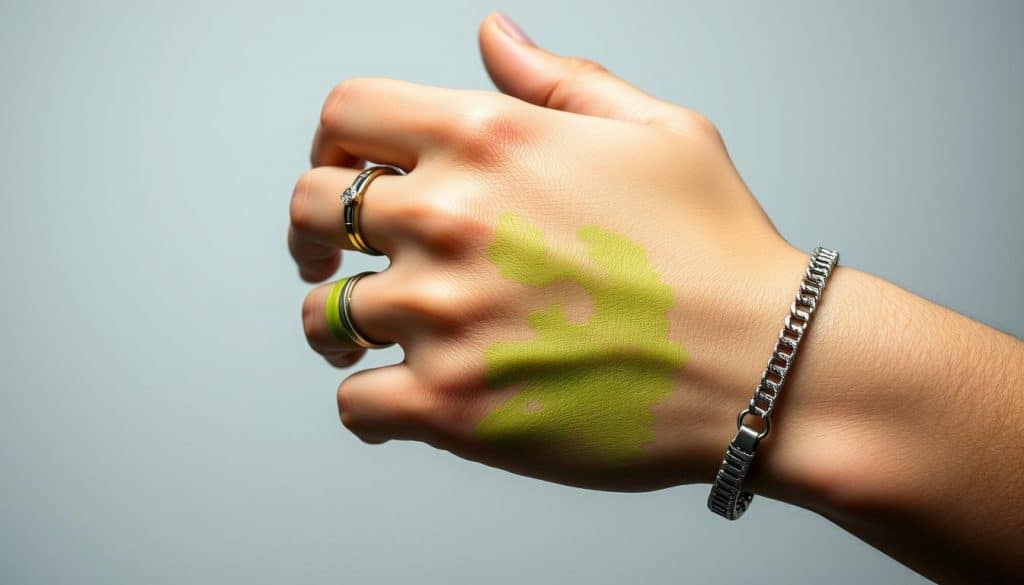
When it comes to jewelry causing green skin reactions, several key factors come into play, affecting how our skin interacts with the metals. Understanding these factors is crucial for minimizing the risk of discoloration.
Climate and Humidity Effects
Climate and humidity play a significant role in the oxidation process of metals, which can lead to green skin reactions. High humidity, in particular, can accelerate the reaction by providing more moisture for the metal to react with. In humid environments, the increased moisture in the air can cause metals like copper to oxidize more rapidly, leading to a higher likelihood of skin discoloration.
Similarly, climates with significant temperature fluctuations can also impact the rate of metal oxidation. Understanding how environmental conditions affect jewelry can help in choosing the right pieces for different climates.
Physical Activity and Perspiration
Physical activity and perspiration are other critical factors that can increase the risk of green skin reactions. When we engage in physical activities, our body perspires, and the sweat can react with certain metals, accelerating the oxidation process. This is particularly true for metals like copper, which react with sweat to form compounds that can cause skin discoloration.
- Perspiration contains salts and acids that can accelerate metal corrosion.
- Physical activity increases the friction between jewelry and skin, potentially irritating the skin and making it more susceptible to discoloration.
Skin pH and Individual Body Chemistry
Individual body chemistry, including skin pH, can significantly influence how our skin reacts to jewelry. People with more acidic or alkaline skin pH may experience different levels of reaction to certain metals. For instance, if your skin is more acidic, it might react more strongly with certain jewelry metals, increasing the risk of green skin reactions.
Moreover, individual differences in body chemistry can affect how metals are absorbed or reacted to by the skin. Understanding your skin’s characteristics can help in selecting jewelry that is less likely to cause adverse reactions.
How to Prevent Jewelry from Turning Skin Green

The green skin discoloration associated with wearing jewelry can be prevented with the right knowledge and care regarding jewelry skin discoloration. By understanding the causes and implementing preventive measures, individuals can enjoy wearing their favorite pieces without the risk of skin discoloration.
Protective Barriers and Coatings
One effective way to prevent jewelry from turning skin green is by applying protective barriers or coatings. Rhodium plating is a popular method for white gold and other jewelry types, as it creates a barrier between the skin and the metal. Additionally, clear nail polish can be applied to the back of the jewelry piece to prevent direct contact with the skin.
We recommend exploring various coating options available in the market, such as:
- Clear coatings
- Rhodium plating
- Ceramic coatings
Proper Jewelry Care and Maintenance
Proper care and maintenance of jewelry are crucial in preventing skin discoloration. Regular cleaning with mild soap and water can help remove dirt and oils that may react with the metal. It’s also essential to store jewelry properly, away from moisture and extreme temperatures.
| Jewelry Type | Cleaning Method | Storage Tip |
|---|---|---|
| Silver | Mild soap and water | Store in a cool, dry place |
| Gold | Ultrasonic cleaner | Avoid exposure to chemicals |
| Copper | Soft cloth and mild soap | Keep away from moisture |
Wearing Habits That Minimize Reactions
Adjusting wearing habits can also play a significant role in minimizing skin reactions. Avoid wearing jewelry during activities that cause excessive sweating, as moisture can accelerate chemical reactions. Additionally, removing jewelry before applying lotions, perfumes, or other chemicals can help prevent unwanted reactions.
“The key to preventing jewelry from turning skin green lies in understanding the metal composition and taking proactive care measures.”
By implementing these strategies, individuals can significantly reduce the risk of jewelry-related skin discoloration. We emphasize the importance of choosing high-quality jewelry and maintaining good hygiene practices.
Hypoallergenic Jewelry Options
Hypoallergenic jewelry has become increasingly popular due to its ability to minimize skin reactions. As we discussed in previous sections, certain metals can cause skin discoloration and irritation. In this section, we will explore hypoallergenic jewelry options that can help alleviate these issues.
When shopping for hypoallergenic jewelry, it’s essential to understand the metals used and their properties. Some metals are naturally more resistant to corrosion and less likely to cause skin reactions.
Metals That Don’t Cause Skin Discoloration
Certain metals are known for their hypoallergenic properties. These include:
- Platinum: Known for its purity and durability, platinum is an excellent choice for those with sensitive skin.
- Rhodium-plated jewelry: Rhodium is a rare, precious metal that is often used to plate white gold jewelry, providing a protective barrier against skin reactions.
- Titanium: Titanium is lightweight, strong, and hypoallergenic, making it an ideal choice for jewelry.
- Niobium: Niobium is a rare earth metal that is often used in hypoallergenic jewelry due to its non-reactive properties.
These metals are less likely to cause skin discoloration and are suitable for individuals with sensitive skin.
Quality Indicators When Shopping for Jewelry
When purchasing jewelry, there are several quality indicators to look out for to ensure you are getting hypoallergenic jewelry:
| Quality Indicator | Description |
|---|---|
| Material | Look for jewelry made from hypoallergenic materials like platinum, titanium, or niobium. |
| Hallmarks or Stamps | Check for hallmarks or stamps that indicate the metal’s purity, such as “950Pt” for platinum. |
| Coatings or Platings | Some jewelry may have additional coatings or platings that enhance their hypoallergenic properties. |
| Brand Reputation | Purchase from reputable brands known for producing high-quality, hypoallergenic jewelry. |
By considering these factors, you can make informed decisions when shopping for jewelry that is gentle on your skin.
“The key to finding the right hypoallergenic jewelry is understanding the materials used and their properties. By choosing jewelry made from hypoallergenic metals, individuals can enjoy wearing beautiful pieces without the risk of skin irritation.”
In conclusion, hypoallergenic jewelry options are available for those who suffer from skin reactions due to certain metals. By understanding the metals used and looking for quality indicators, consumers can make informed choices.
How to Clean Green Skin Discoloration
Removing green skin discoloration caused by jewelry can be achieved through simple yet effective methods. When skin reacts with certain metals in jewelry, it can result in an unsightly green mark. We will guide you through immediate remedies and long-term skin care solutions to address this issue.
Immediate Remedies for Skin Stains
For immediate relief, washing the affected area with mild soap and water is often sufficient to remove the green discoloration. Gentle exfoliation can also help in removing the top layer of skin where the reaction occurred.
- Wash the area with mild soap and lukewarm water.
- Gently exfoliate using a soft cloth or a gentle scrub.
- Apply a soothing moisturizer to hydrate the skin.
Long-term Skin Care Solutions
To prevent future occurrences, adopting a long-term skin care routine is essential. This includes using barrier creams before wearing jewelry and ensuring the jewelry is properly cleaned and maintained.
| Solution | Description | Benefits |
|---|---|---|
| Barrier Creams | Apply before wearing jewelry | Prevents metal from coming into contact with skin |
| Jewelry Cleaning | Regularly clean jewelry with appropriate solutions | Reduces tarnishing and reaction risk |
| Skin Moisturizing | Keep skin hydrated | Maintains skin health and resilience |
By combining immediate remedies with long-term care, you can effectively manage and prevent green skin discoloration caused by jewelry.
Jewelry Coatings and Treatments to Prevent Reactions
The right coatings and treatments can make jewelry more comfortable to wear and prevent adverse skin reactions. By applying a protective barrier between the skin and the jewelry, individuals can significantly reduce the risk of discoloration and irritation.
Professional Jewelry Treatments
Professional jewelry treatments involve applying advanced coatings that are designed to prevent skin reactions. These treatments are typically more durable and long-lasting compared to DIY solutions.
- Rhodium Plating: Often used for white gold jewelry, rhodium plating provides a protective layer that prevents skin contact with the base metal.
- Ceramic Coating: A modern solution that creates a barrier between the jewelry and the skin, ideal for sensitive skin.
- Gold Plating: For base metals, gold plating can be an effective way to prevent skin reactions by creating a layer of gold between the skin and the metal.
| Treatment Type | Durability | Skin Reaction Prevention |
|---|---|---|
| Rhodium Plating | High | Excellent |
| Ceramic Coating | Medium to High | Very Good |
| Gold Plating | Medium | Good |
DIY Solutions for Protecting Jewelry
For those looking for immediate or cost-effective solutions, DIY treatments can be a viable option. One common method is applying clear nail polish to the back of the jewelry piece.
- Clear Nail Polish: Creates a temporary barrier that can last several weeks depending on wear.
- Jewelry Barrier Creams: Available in the market, these creams can be applied to the jewelry or the skin to prevent reactions.
By understanding and utilizing these coatings and treatments, jewelry wearers can enjoy their pieces without the worry of unwanted skin reactions. Whether opting for professional treatments or DIY solutions, there’s a method to suit every need and preference.
Common Misconceptions About Jewelry and Skin Reactions
There’s a plethora of misinformation surrounding jewelry and its impact on skin, necessitating a closer examination of the facts. Many consumers are unaware of the actual causes of skin discoloration and metal allergies, often leading to misconceptions about the quality and safety of certain types of jewelry.
Fake vs. Real Jewelry Myths
One common myth is that only fake or costume jewelry causes skin reactions. However, even genuine jewelry made from precious metals can cause discoloration under certain conditions. The key factor is not the jewelry’s authenticity but rather its composition and the wearer’s skin chemistry.
For instance, gold jewelry is often considered safe, but certain alloys mixed with gold can react with skin, especially if the gold content is less than 14 karats. Similarly, silver jewelry can tarnish and cause skin discoloration, not because it’s fake, but due to its reaction with environmental factors.
Price vs. Quality Considerations
Another misconception is that expensive jewelry is always hypoallergenic or of higher quality in terms of skin compatibility. While it’s true that some high-end jewelry brands use superior materials and craftsmanship, the price doesn’t always correlate with the metal’s reactivity.
Consumers should look beyond the price tag and focus on the jewelry’s material composition. For example, some affordable jewelry made from hypoallergenic materials like surgical stainless steel or titanium can be more suitable for sensitive skin than expensive gold or silver pieces that contain reactive alloys.
When shopping for jewelry, it’s crucial to consider the materials used and their potential impact on your skin. By understanding the facts and dispelling common myths, you can make more informed decisions and enjoy wearing jewelry without adverse reactions.
When to Consult a Dermatologist About Jewelry Reactions
Jewelry reactions can sometimes indicate a more serious skin issue, necessitating a visit to a dermatologist. While many skin reactions to jewelry are mild and temporary, some can be signs of underlying allergies or sensitivities.
Signs of Actual Metal Allergies
Metal allergies, particularly to nickel, are common and can cause significant skin reactions. If you experience any of the following symptoms, you may have a metal allergy:
- Redness and itching that persists even after removing the jewelry
- Rashes or blisters that develop after wearing certain jewelry
- Swelling or inflammation around the area where the jewelry was worn
- Darkening or discoloration of the skin that doesn’t fade
A dermatologist can diagnose metal allergies through patch testing, which involves applying small amounts of various metals to the skin to observe reactions.
Treatment Options for Severe Reactions
If you’ve experienced a severe reaction to jewelry, there are several treatment options available. These may include:
| Treatment | Description |
|---|---|
| Topical corticosteroids | Creams or ointments that reduce inflammation and itching |
| Oral antihistamines | Medications that can help alleviate itching and reduce allergic responses |
| Barrier creams | Products applied to the skin before wearing jewelry to prevent reactions |
For individuals with severe metal allergies, avoiding certain types of jewelry is crucial. A dermatologist can provide personalized advice on managing metal allergies and recommend hypoallergenic jewelry options.
We emphasize the importance of seeking medical attention if symptoms persist. By understanding the signs of metal allergies and exploring treatment options, you can enjoy wearing jewelry while maintaining healthy skin.
Conclusion
Understanding why jewelry turns skin green is crucial to preventing this common issue. As we have discussed, the chemistry behind metal corrosion and individual body chemistry play significant roles in determining whether jewelry will cause skin discoloration.
To minimize the risk of jewelry turning your skin green, it’s essential to maintain good jewelry hygiene. Regularly cleaning your jewelry and storing it properly can help prevent the oxidation process that leads to skin discoloration.
We recommend taking preventive measures, such as applying a protective barrier between your skin and jewelry, to reduce the risk of green skin. By choosing high-quality, hypoallergenic jewelry and being mindful of your body chemistry, you can enjoy wearing jewelry without worrying about unsightly skin stains.
By following these tips and being aware of the factors that contribute to jewelry turning skin green, you can confidently wear your favorite pieces while maintaining healthy, green-free skin.
FAQ
Why does jewelry turn my skin green?
Jewelry turns skin green due to a chemical reaction between the metal and the skin, often caused by the presence of copper or other reactive metals.
What metals commonly cause green skin discoloration?
Copper, brass, and bronze are common metals that cause green skin discoloration due to their reactivity with skin and environmental factors.
Is green skin from jewelry harmful?
Generally, green skin from jewelry is not harmful, but it can be a sign of a metal allergy or irritation, and in some cases, it may indicate a more serious reaction.
How can I prevent jewelry from turning my skin green?
To prevent jewelry from turning skin green, apply a protective barrier, maintain good jewelry hygiene, and choose hypoallergenic jewelry options.
What is the difference between fine silver and plated silver?
Fine silver is made entirely of silver, while plated silver is a base metal coated with a layer of silver, which can wear off over time, potentially causing skin reactions.
Can gold jewelry cause skin discoloration?
Gold jewelry can cause skin discoloration if it contains alloys or impurities that react with the skin, but high-karat gold is less likely to cause reactions.
How do I clean green skin discoloration?
To clean green skin discoloration, use gentle soap and water, and consider applying a barrier cream or lotion to help remove the discoloration.
What are hypoallergenic jewelry options?
Hypoallergenic jewelry options include metals like titanium, niobium, and surgical stainless steel, which are less likely to cause skin reactions.
When should I consult a dermatologist about jewelry reactions?
Consult a dermatologist if you experience persistent or severe skin reactions, or if you suspect a metal allergy.
Can I prevent jewelry reactions with coatings or treatments?
Yes, applying coatings or treatments to jewelry can help prevent skin reactions, and professional treatments or DIY solutions can be effective.
Are expensive jewelry pieces less likely to cause skin reactions?
Not necessarily, as the likelihood of skin reactions depends on the metal composition and quality, not just the price.
share this recipe:
Still hungry? Here’s more

Gold Filled vs Vermeil Guide Differences Durability and Value
What Is Gold Filled Jewelry? Gold filled jewelry is my go-to recommendation when someone wants

How Much for a Gold Necklace 2026 Price Guide and Tips
Understanding Gold Purity and Karats When people ask “how much for a gold necklace?”, the

Spiritual Jewelry Symbols Guide- Meanings and How to Choose
How to Use This Spiritual Jewelry Symbols Guide Spiritual jewelry only works for you when
Ready to Design Your Own Jewelry?
Have an idea in mind or need help shaping it? From sketches to finished pieces, our custom jewelry team will work with you step-by-step to bring your vision to life.
